Everything you need to know about cannabis seedlings
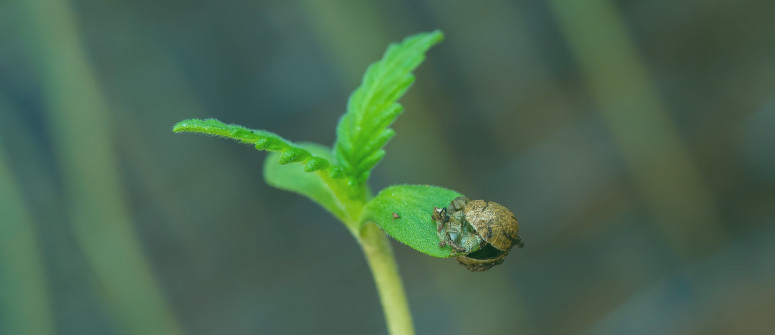
Optimising the seedling stage of the cannabis life cycle is absolutely crucial to achieving a successful harvest! At this point in their lives, plants are fragile, and any damage can have potentially severe consequences. Fortunately, with this guide, you won't have to take any chances. Find out all you need to know about the seedling stage.
Contents:
When people think of growing weed, they often picture large plant after large plant uniformly standing beneath high-powered grow lights. Seldom does the mind first go to delicate little seedlings that have just emerged from the earth. But, of course, this is how a cannabis plant begins its life. And the growing process begins even before this; before germination, in fact.
In this article, we take an in-depth look at cannabis seedlings, and cover everything you need to know about how to prepare and care for them, as well as how to transplant them effectively.
What are cannabis seedlings?
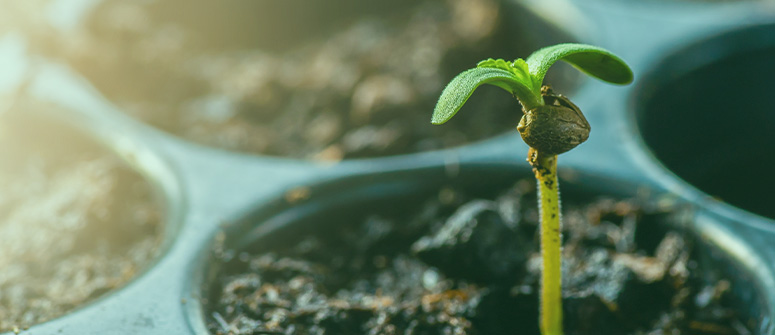
Cannabis seedlings are, aside from cannabis seeds, the first iteration of a cannabis plant. From the moment the seed splits open and the cotyledons (aka “seed leaves”) first show themselves, you have a cannabis seedling. At this point, the taproot of each seed will delve into the earth (or inert media) in search of water, anchorage, and nutrients, while, above ground, a stem and leaves will grow upward in search of space and light.
Unlike human babies and toddlers, cannabis seedlings don’t take long to grow. In fact, the average seedling only exists for around 10 days, after which it enters the vegetative stage. Perhaps a better way to tell is by the number of true leaves it has; true leaves are the characteristic cannabis fan leaves that occur after the development of the cotyledons. Once a seedling has developed three sets of true leaves, it is considered to have entered the early vegetative stage.
How to grow cannabis seedlings
Growing cannabis seedlings isn’t too difficult, but it does require care and patience. Although getting it right isn’t too hard, getting it wrong can have dire consequences. Cannabis seedlings are fragile and can easily die or become permanently stunted. Unlike other periods during a cannabis plant's life, the seedling stage is not one where it’s so easy to get away with making mistakes.
As such, it’s advisable to germinate all cannabis seedlings indoors, even if you intend to grow them outdoors or in a greenhouse. This is because adverse weather and drops in temperature can quickly and irreversibly damage your young plants. Growing indoors provides a much greater degree of control.
In the following sections, we will outline preparation, germination, and how best to care for your seedlings once they have sprouted above the earth.
1. Preparation: Genetics, pots, and medium
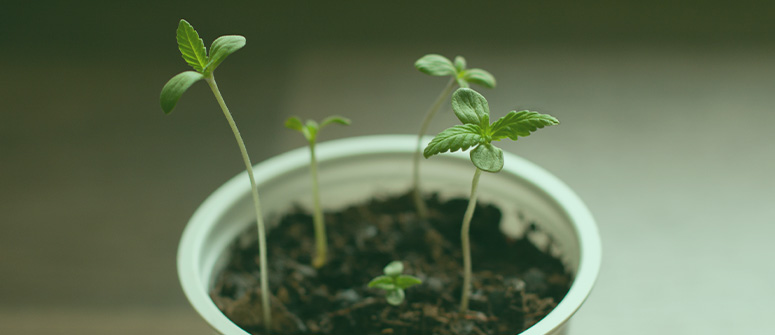
If you want your cannabis seedlings to get a good start in life, and develop into vigorous and generous mature cannabis plants down the line, then you need to get everything right from the start—before you even germinate the seeds. Given this, picking the correct genetics, pots, and media are crucial. Without considering and optimising these factors, your grow is unlikely to go the way you intend it to.
Genetics
First off, picking suitable genetics will go a long way to determine whether your grow is successful or not.
Some cannabis cultivars are naturally robust and will grow healthily even when the odds are stacked against them. Likewise, there are those that will keel over and die at the slightest sign of trouble.
Therefore, select genetics that will grow well in the environment you provide for them, and that your growing skills can accommodate. For instance, a Thai landrace seedling will surely fail if grown outdoors in northern Britain, even if done so by an expert. Similarly, a novice would be better off with some tough indica hybrid that can easily handle less-than-perfect conditions.
It’s also worth considering whether you will grow autoflowering or photoperiod cannabis plants, as this makes a difference in terms of how you treat them from their very first day of life.
Generally, autoflowering plants are hardier than photoperiods, with one exception: during the seedling stage! As autos switch to flowering after a predetermined amount of time, any damage they incur when young is very difficult to repair, and as such can cause lasting damage. More on this below.
Pots
Given the difference between autoflowering and photoperiod genetics, most growers germinate autoflowering seeds in their final pots. This removes the risk of damaging the roots during transplantation, which can do irreversible damage. So for autoflowering cannabis plants, consider planting seeds in fabric pots of around 11 litres. Fabric pots are best as they offer great aeration and drainage, which cannabis plants adore.
For photoperiod plants, on the other hand, many growers choose to germinate their seeds in propagation chambers. These small chambers, specifically designed for germination and seedlings, hold the correct amount of water and maintain a high humidity level, which is a must for germinating seeds.
After the seedling phase, the young plants can be transplanted to fabric pots or a flower bed. The exact size of the containers or plot will depend on the genetics and the desired final size of the plants.
Medium
Choosing the appropriate growing medium will make a big difference in how your seedlings fare. Simply put, novice growers should opt for soil, as this provides the most stable and hospitable environment for cannabis seedlings.
Good-quality soil should:
- Have a correct pH level (between 6.0 and 7.0)
- Hold water in a beneficial way
- Exhibit adequate drainage and aeration
- Contain all the necessary nutrients for seedlings to grow
The issue with inert media (like coco coir or Rockwool) is that you will need to add fertiliser and adjust pH levels from the get-go, which can be very difficult at the best of times. When germinating cannabis seeds and growing seedlings, it can be even more difficult to get these factors right.
On the other hand, good-quality soil will not require adjustments during the early stages, meaning it can be as simple as planting a seed and watering a little.
2. Germination: 3 methods
There are three commonly used methods for germinating cannabis seeds. For autoflowering seeds, we’d recommend going for the first option (directly in soil). Otherwise, you can take your pick depending on what seems best to you.
Directly in soil
Germinating seeds in soil is probably the simplest method, and often the most effective. It certainly reduces the chances of something going horribly wrong at the very first step!
This can either be done in a final pot, or in a propagation chamber or starter kit. Starter kits are a great choice for beginners, or those who just want an easy and effective way to germinate their seeds.
To germinate in soil, it's important to ensure that it isn’t too wet or too dry, and that you maintain a high humidity—around 90%. As mentioned, good soil should already contain all the necessary nutrients and the correct pH level for seedlings to thrive.
Note that planting weed seeds directly in soil may result in a longer germination period than the methods directly below.
Paper towel method
Alternatively, it’s possible to germinate seeds wrapped in damp paper towels, placed in a warm and dark environment. Once the seed opens and the taproot appears, it should be transplanted into soil (or another growing medium).
Glass of water method
You can also germinate seeds by submerging them in a glass of water. For this method, simply drop them into a glass of pure, warm water. As with the paper towel method, once the taproots appear, they should be planted in some kind of growing medium.
Do cannabis seeds need light to germinate?
No, cannabis seeds do not require light to germinate. In fact, a dark environment is ideal. It is actually the high humidity and temperature that trigger the germination process in cannabis seeds. The ideal temperature for germination is 25°C, with a relative humidity of 90%.
3. Caring for cannabis seedlings: 6 important factors
Once you’ve germinated your seeds, the long journey of caring for your plants begins. Each stage of a cannabis plant’s life requires specific care, but the seedling stage is significantly different from the later stages. In the following section, we’ll outline the major factors that you should be aware of when raising cannabis seedlings.
Light
Everyone knows that cannabis plants require a lot of light, whether from the sun or from grow lights.
If you germinate your seeds in late spring or early–mid summer, it is possible to grow seedlings outdoors from day one. However, this is only recommended in climates where you can be certain that nighttime temperatures will not become too low, and that serious wind or rain won’t occur.
Alternatively, a greenhouse can be a perfect stepping stone between indoor and outdoor growing. Here, you can harness the power of the sun, and combine it with the controlled, protected environment of a greenhouse.
Finally, you can grow marijuana indoors using grow lights. For seedlings, it’s advisable to use CFL grow lights, which emit light mostly from the blue end of the spectrum. Blue light simulates the light of spring, and causes plants to develop robust and healthy root systems—which is crucial during the seedling stage.
Whichever method you opt for, be careful that you get the balance of light right. Too little light, and you might notice your seedlings shoot upward at a surprisingly fast rate, becoming thin and spindly. This is called etiolation (aka stretching). Plants stretch when they detect a lack of light; in nature, this is an attempt to break through the canopy blocking the light from reaching them.
While stretching might seem like a good thing to the uninitiated, it causes overly tall, weak plants that can snap and fall over.
On the other hand, if the grow lights are too strong or too close, then seedlings can suffer from light burn. In this case, you’ll notice discolouration—especially browning—on the upper leaves. If it progresses, leaf edges may curl and become crisp. If this happens, just increase the distance between the plants and the lights.
Temperature
What temperature should you use for cannabis seedlings? In nature, these little beings appear in spring, so they’ve evolved to thrive at slightly lower temperatures compared to adult cannabis plants.
The ideal temperature range for cannabis seedlings is 20–23°C during the day. At night, things can cool off a little, but try to keep the difference fairly small. Anything less than 16°C can start to cause issues.
Humidity and water
Cannabis seedlings like a relative humidity of 65–70%. This is slightly higher than adult cannabis plants, and can be difficult to achieve depending on your growing environment. This is another reason that growing in a greenhouse or grow tent is a good option, at least for seedlings.
Are your cannabis seedlings turning yellow? This is likely due to overwatering. Overwatering is always dangerous for cannabis plants, but it poses perhaps the greatest threat during the seedling stage, as young plants are incredibly fragile and their small root systems simply can’t drink that much.
With that in mind, water enough to make sure the soil is moist, but not sopping wet. In most cases, seedlings will probably only need to be watered once or twice before they progress to the vegetative stage. If the top of the soil is still damp to the touch, do not water!
Likewise, if it’s clearly dry, then do give your seedling some water.
Seedlings can also suffer from fungal infections that swiftly kill them. This is known as “damping off”. Most often, damping off occurs as a result of overwatering, which gives fungi a perfect environment in which to grow. Seedlings suffering from this affliction will first exhibit tiny white dots at the base of the stem. Here, the stem is weakening, and later, it will discolour and eventually collapse.
Finally, your water should have the correct pH level—6.0–7.0 in a soil grow. It may well be the case that the water you use already falls within this range, but some tap water can measure above 7.0. If this is the case for you, use a pH down solution to get it to the right level. These can easily be made at home or purchased at dedicated garden stores.
Nutrients
The good news with cannabis seedlings is that, in most cases, they won’t need feeding. High-quality soil will have all the nutrients necessary to get seedlings through to the vegetative stage, at the very least.
In case you choose to grow in inert media, then you will need to add nutrients. However, you must be careful; seedlings require very little fertilisation.
Airflow
A supply of fresh air is always good for cannabis plants, as it stops the buildup of pathogens, such as harmful fungi.
For cannabis seedlings, though, air movement is also beneficial in that it helps to strengthen the stems. Use an oscillating fan to pass air over your seedlings to ensure they’re robust later on in life. The tiny movements cause micro-tears in the stem tissue, which, like with animal muscle, repairs tougher and stronger.
Pest and pathogen control
Seedlings are particularly susceptible to pests and pathogens, such as the fungi that cause damping off.
To avoid issues, use clean soil. For instance, buy high-quality potting soil rather than taking a shovel load from the garden. Potting soil will be free from pathogens and rich in nutrients, so it’s a win-win.
Furthermore, keep an eye out for signs of trouble during the seedling stage. Fungus gnats are one significant threat. These tiny gnats buzz around soil that is too wet. If you see them, it’s a sure sign that your soil needs to be dried off.
When and how to transplant seedlings
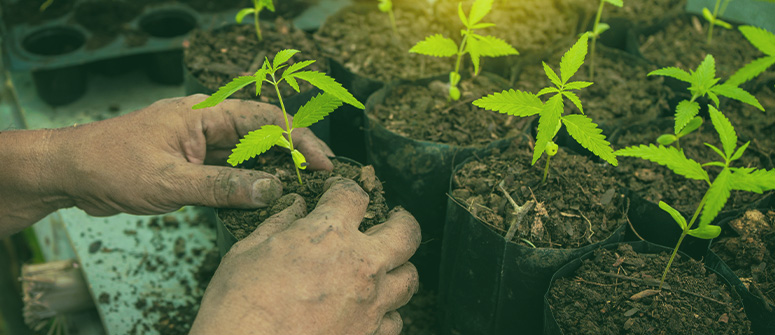
Once seedlings reach a certain stage, they are ready to be transplanted into larger pots, and perhaps to a different environment too.
There is no sure-fire way to tell when seedlings are ready to be transplanted, nor is there an exact time frame. However, there are cues we can take from the plant itself. One sign is if the leaves are as wide (or wider) than the container that the seedling is growing in, if you’ve chosen to grow your seedlings in small containers. This indicates that the root system is probably close to filling the pot.
To make sure of this point, you can gently try to remove the seedling from its pot. If the roots are densely developed, then the seedling should come out with all of the soil firmly attached. If this is the case, it requires a bigger space in which to grow.
Once seedlings are transplanted, it’s time to start giving them nutrients (unless you’re using homemade super soil, which releases nutrients slowly over time). Start with around ¼ of what is recommended on the fertiliser/feed that you are using. Administering a full dose while plants are this young risks overwhelming them and causing nutrient burn.
When can seedlings go into a greenhouse?
Seeds can be germinated in a greenhouse setting outright. However, if you’ve started them indoors, it’s probably best to move them into a greenhouse incrementally over several days. Once you’ve transplanted them, you can begin bringing the plants into a greenhouse for a few hours a day. Over a week or two, increase the amount of time each day to get them used to their new environment. Soon, you’ll be able to leave your plants there for the rest of their lives.
When can seedlings go outside?
As with moving plants into a greenhouse, seedlings need to be carefully, incrementally exposed to the outdoors. This process, known as “hardening off”, takes anywhere from a few days to a couple of weeks.
To be safe, move plants outdoors during the hottest part of the day for the first few days, before gradually exposing them to full days, and eventually a full day and a night. Soon they’ll be hardened off and you’ll be able to leave them permanently.
When can cannabis seeds handle direct sunlight?
Being plants, cannabis seedlings can handle direct sunlight from day one. However, when germinated and reared indoors under artificial lights, they may need some “hardening off” regarding direct light too. Start them under a few hours under cool CFLs for a few days before exposing them to consistent light.
Grow cannabis like a pro
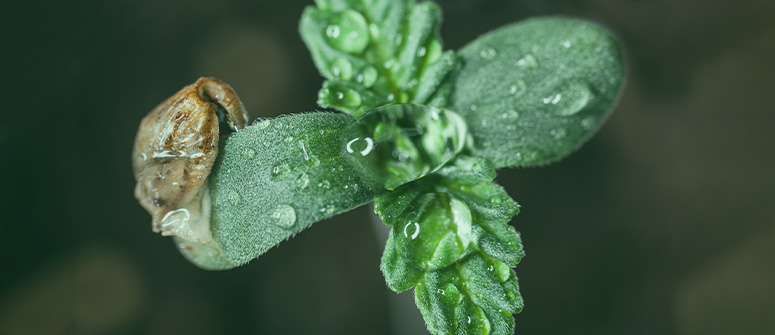
If you can master the seedling stage of cannabis cultivation, then you’ll put yourself in very good stead for the later parts of the grow too. The vegetative and flowering stages will be much easier (and more productive) if the plant got the best start in life, as it will be robust and able to direct its energy toward vigorous growth and flowering, rather than recovery.
After all of this is over, all you need to do is harvest, dry, and cure your buds, and then you can finally enjoy them!




